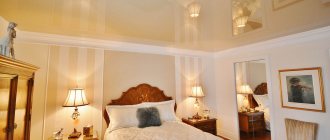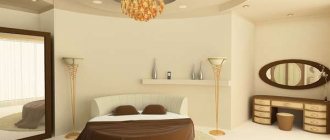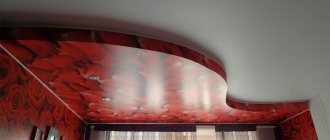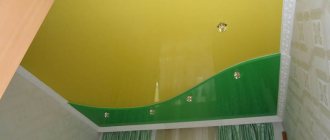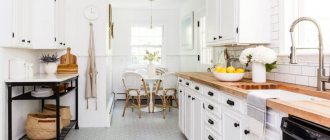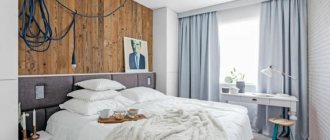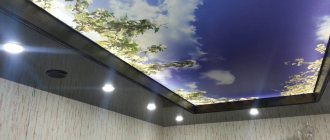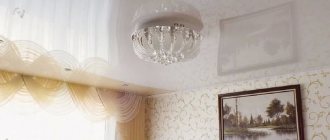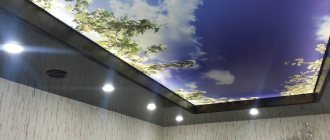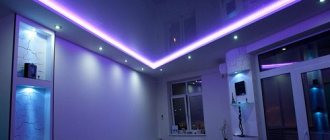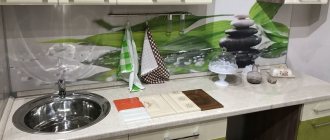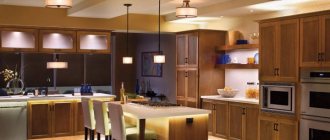The ceiling is the most unused plane in the room, which can easily replace an accent wall and become the highlight of the interior. This is a powerful design tool that will help visually divide a room into functional zones and provide each of them with the necessary lighting.
Why do stretch fabrics compete powerfully with other finishing methods? Let's start with the fact that they are made from different materials, each of which has its own qualities and distinctive appearance.
Advantages and disadvantages of suspended ceilings
The reason for the popularity of these paintings is that they have more pros than cons.
So, the advantages of suspended ceilings in the kitchen include:
- simple (and possibly even cheaper) installation, taking a few hours;
- dust-free repairs, for which you do not always need to remove furniture;
- quick renovation of the interior by changing the canvas;
- moisture resistance and fire safety of the material;
- ease of care;
- absence of condensation, and, accordingly, no reason for the formation of mold and fungi;
- masking ceiling irregularities and communications;
- wealth of colors and textures;
- wide possibilities for lighting design;
- durability (12-15 years).
And most importantly, thanks to their diversity, stretch ceilings will fit into any interior style, as evidenced by these photos.
The disadvantages of suspended ceilings are often associated with low-quality materials or unscrupulous installation.
If we exclude these factors, suspended ceilings in your kitchen may have the following disadvantages:
- the presence of connecting seams when decorating large rooms (width more than 3.2 m);
- loss of 5-10 cm in room height;
- limiting the power of light bulbs built into the ceiling.
All other accusations against suspended ceilings can be called prejudices associated with:
- ignorance of the characteristics and range of uses of polyvinyl chloride, polyester and polyurethane;
- lack of ventilation necessary for the kitchen;
- low-quality fakes with a characteristic pungent odor that does not disappear within a couple of days after installation.
Materials, prices and manufacturers
Stretch ceilings are made of polyvinyl chloride (PVC film) or polyester impregnated with polyurethane.
The first option is the most famous. If your renovation budget is limited, then vinyl is your choice.
Fabric ones are distinguished by texture - weaving (pronounced or barely noticeable).
Fabric textured with shade
There are differences between fabric and vinyl according to the installation method. The PVC film is stretched using a special heat gun onto aluminum profiles pre-installed around the perimeter. Fabric ones do not require such equipment; they are attached to a frame.
Care will also be different: fabric can only be dry cleaned, PVC film can be washed with water or soapy water.
You can clearly see the prices, pros and cons of each material in the comparative table below.
| Materials | Price* per 1 sq.m. | Advantages and disadvantages | |
| + | — | ||
| Polyvinyl chloride (PVC) | From 150 rubles (Chinese production), from 350 (European production). With photo printing – from 2,500 rubles | 1. Large difference in cost. 2. Large selection of designs. 3. They save you from flooding by holding water. | 1. Airtight (not suitable for damp areas). 2. They have restrictions on the use of chandeliers and lamps (read in the last paragraph). 3. Large rooms will have seams. 4.Easy to tear. |
| Fabric (polyester+polyurethane) | From 450 rubles (Descor), from 880 rubles (Clipso). With photo printing – from 2,500 rubles | 1. They breathe and completely eliminate the risk of fungus formation. 2. More durable. 3. Seamless. 4. Compatible with any chandeliers. | 1. They cost more than PVC films. 2. Waterproof only up to 2 days. 3. There is less choice in design. |
*Prices are indicated for the Moscow region. In regions, the cost may vary slightly.
The price is for material excluding installation. The price for the work is about 400 rubles per sq.m.
Among all manufacturers of vinyl ceilings, the French brands have the best reputation: Barrisol (premium), Alkor Draka, EXTENZO.
German production - RENOLIT, Lackfolie, and Belgian - PTCM Polyplast gained trust.
Russian production lags somewhat behind European competitors in terms of technology, but is also gaining momentum. Among Russian companies, one can highlight SAROS DESIGN.
China represents the budget segment, but this does not mean that there are no quality ones among the Chinese. The MSD and Gline brands have good reviews.
The most popular brands among fabric manufacturers are those with patented manufacturing technology:
- Descor (Germany). They are distinguished by a universal design, the surface is smooth with a slightly noticeable weave;
- Clipso (Switzerland with production in France). Unlike its German competitor Descor, the fabrics of this brand have a more pronounced weave texture;
- Cerutti (Italy). This brand focuses on multi-layering, making them durable and airtight.
See also about the pros, cons and environmental safety in the video:
Levels
If the ceilings in the kitchen are high, you can easily afford a two-level design made of matte and glossy, fabric and PVC canvases.
You can also make a combination of suspended ceilings with plasterboard. It is less resistant to moisture, but more resistant to high temperatures, which gives more possibilities in terms of lighting devices. Glossy stretch fabrics and plasterboard are used to create coffered ceilings.
Two ceiling levels are an excellent solution for zoning the kitchen-living room or separating the dining room from the work area in spacious kitchens. In addition, this way you will complement the color scheme of the kitchen.
The lower level of the ceiling, following the curves of the kitchen unit, will give you a harmony of shapes, and the spotlights built into it will provide powerful lighting, just necessary for the work area.
In the same way, the ceiling can duplicate the outline of the table, and the image printed on it with appropriate lighting will create a romantic or festive mood.
One might assume that for a small kitchen complex hanging structures are not an option, but this is not always the case.
Design options for two-tier or multi-tiered stretch ceilings await you in the following photos.
What should plasterboard ceilings look like?
Covering the ceiling with plasterboard allows you to create both a flat surface and a complex multi-tiered structure. But in a small room, an abundance of steps, false beams and similar protruding elements is inappropriate, as it clutters up the space. It is better to make a flat or two-tier ceiling, lowering the level only where the exhaust and ventilation pass.
In a small kitchen, two types of gypsum board ceilings are used:
- Hanging (more common). A frame is erected from an aluminum profile, which is then covered with sheets of plasterboard. The lathing is placed as close as possible to the ceiling so that the ceiling drops slightly (the minimum distance is about 7 cm).
- Hemmed . This option is chosen when the slabs in the house are located fairly evenly or a wooden floor is made. Drywall is attached directly to the base.
In both cases, it is necessary to putty the seams and various irregularities. The surface is primed and painted. The entire process usually takes several days.
Important! The basis of the plasterboard sheet is gypsum, covered on both sides with layers of cardboard. Additionally, various additives are used that affect the properties of the material. For the kitchen, it is recommended to take a moisture-resistant variety - gypsum plasterboard, which is easily recognized by its green tint. The color will disappear after all stages of finishing and will not be noticeable.
Single-level
Owners of low rooms will not want to sacrifice extra centimeters for height-eating structures. Here we recommend paying attention to single-level glossy ceilings, the reflectivity of which radically changes the situation.
You will not feel the loss of height and will make the entire kitchen feel noticeably more spacious. One caveat - a minimum number of objects must be reflected, otherwise the effect will be the opposite.
Interiors with an abundance of decor or just neatly arranged kitchen utensils are more likely to be suited to matte ceilings, reminiscent in texture of the most ordinary plaster.
Satin fabrics are an elegant design with shimmers characteristic of natural fabrics. If white fabric ceilings look like a standard, but in fact more practical whitewash, then colored ones look like expensive, ironed and crisp fabric. How satin stretch ceilings look in the kitchen is shown in the photo below.
There is also something in between glossy and matte finishes - semi-gloss ceilings with a pearlescent or metallic sheen. Compared to gloss, they reflect light much less and are a little “grainy,” which is especially visible when backlit.
These canvases are in perfect harmony with chrome or metal interior elements, characteristic of styles such as hi-tech, futurism or techno. This coating changes appearance depending on the intensity and direction of lighting.
Varieties
When choosing a material, you need to know that there are film and fabric types.
Films are made of polyvinyl chloride. According to their texture, they are divided into:
- glossy - they display the room’s decor and lighting like a mirror;
- matte - without shine, but fits well into any interior;
- satin - softly reflect light, creating a mother-of-pearl effect.
Photo: Instagram @sibelektrotorg
Photo: Instagram @masterpotolkovnsk
Photo: Instagram @sibelektrotorg
Fabric ones consist of an interweaving of synthetic threads processed in a special way. The main advantage of this type is the ability to “breathe,” which is important for a kitchen with its high humidity. Another plus is the fabric’s resistance to sub-zero temperatures. Fabric fabrics are not afraid of frosts down to minus 40 degrees and heat up to plus 80 degrees.
Photo: Instagram @mir_potolkov_kirov
Photo: Instagram @studiokomforta
Photo: Instagram @remont.grad
Interesting textures
During its relatively short existence, stretch fabrics have been replenished with a number of new unusual textures.
For example, chameleon canvases take on the shades of their surroundings.
No less impressive are stretch ceilings that imitate:
|
|
Now imagine how many design options their combinations will give!
Beautifully crumpled fabric on the ceiling will add volume to an avant-garde kitchen, bohemian gilding will complement rooms in art deco, baroque, and other luxurious styles. Imitation of wooden beams will help complete the look of a kitchen decorated in styles such as Biedermeier, country, rustic, chalet, hygge. Compared to natural wood, stretched kitchen canvases are more practical, not to mention the difference in price.
Such abundance gives stretch ceilings access to luxurious, sophisticated and simple, rustic styles. And here are photo examples confirming this.
The passion of modern designers for combining materials has also given rise to a new type of suspended ceilings, reminiscent of the design of a spaceship or an apartment in the distant future.
Perforated ceilings
First, we suggest you make sure that they really look fantastic by looking at these photos. The recipe for this spectacle is quite simple: lighting, a special baseboard, a ventilation system and two canvases superimposed on each other - solid and with slots.
The holes are not only round, but also openwork, in the form of drawings or ornaments. In addition to the incomparable appearance, the advantages of this innovation that distinguish it from conventional single-layer canvases include:
- increased resistance to moisture;
- improved ventilation of canvases;
- obtaining a 3D effect.
But there were some downsides, too, and these are:
- more complex installation;
- accumulation of dust between the canvases;
- loss of at least 25 cm of room height.
Well, it’s quite natural that perforated ceilings are more expensive than regular ones.
Starry sky
It is unlikely that anyone will refuse to enjoy the starry sky, comets, planets or entire galaxies while sitting in their kitchen. Therefore, this design has not lost popularity over the years and will soon probably receive the title of classic.
You can transfer the sky to the ceiling in different ways - for example, using:
- graphic image;
- fiber optics;
- LED backlight;
- luminescent paint;
- Starpins pins;
- diffusive lenses from Swarovski;
- combinations of all of the above.
A special light generator will provide monotonous twinkling of the stars, and if you want, all sorts of special effects like flying comets, new constellations appearing on the horizon and shooting stars. Here are a few photos of what stellar suspended ceilings look like in the kitchen.
Installation features
Due to differences in the materials used, the coating installation methods also differ. For textile bases, the “cold” method is more typical, in which the fabric is simply stretched along the contour of the room.
A more complex method is used when installing PVC coverings. For this purpose, a so-called gun is used, which heats the plastic. The material stretches, acquiring special plasticity as a result of heating. The covering is carefully pulled over the pre-established contours.
At the same time, there should be no failures during the repair work, otherwise the canvas will not receive a perfectly flat surface. Therefore, if you do not have the necessary skills, it is better to entrust the work to a specialist in installing suspended ceilings.
In this case, preliminary preparation of the ceilings is carried out, and gross defects are eliminated (small defects will be hidden under the coating used).
floating ceiling
And here is another amazing symbiosis of suspended ceilings and LED lighting. Even the most unsightly stretch fabric installed using this technology looks extraordinary. The secret of the flying ceiling is a special profile into which an LED strip is embedded at a certain angle.
Fully justifying their name, such ceilings visually enhance the room. One “but” - the floating effect will be hidden by a wall unit or high kitchen modules, because the diodes illuminate 10-20 cm of the walls under the ceiling.
What should you not be afraid of?
There are still many myths around suspended ceilings and their use in the kitchen. This is all the more surprising since everyone now has access to information, but, nevertheless, we will try once again to debunk them here and now.
It will quickly turn yellow from grease and soot. Polyvinyl chloride fabric is not afraid of either the sun's rays or steam with fat impurities rising from the kitchen stove, so even the snow-white fabric will definitely not lose its freshness. But this does not at all negate the fact that it needs to be looked after. More details about this in a separate paragraph below.
Over time it sags and wrinkles. If the stretch ceiling is poorly stretched, it will sag and wrinkle immediately , and not after some time. We recommend that you contact reliable specialists to avoid such problems.
The fabric tears easily. Yes, it can be torn and damaged if you do not follow basic cleaning rules and use abrasive detergents with aggressive ingredients. But in general, it is quite dense and elastic, so it is not at all a fact that a cork that bounces off while opening a bottle of champagne will be able to break through it as easily as, for example, any sharp object.
If flooded, it must be replaced immediately. The most famous stereotype that can be easily destroyed by watching just one video on the topic. We attach it below.
Vinyl fabric contains impurities hazardous to human health. On the contrary, suspended ceilings are environmentally friendly and meet sanitary standards. It is no coincidence that they have international certificates and are popular in the EU zone, known for its strict quality criteria for finishing products.
May ignite. They cannot and do not ignite because they are completely fireproof and according to this indicator they have a level of KM2 or KM3. This means that they only melt when in direct contact with fire (like most other materials), but cannot ignite from a spark or elevated temperature alone.
Photo printing
Are you striving for uniqueness in your design? Or do you want to make your kitchen larger and taller? Opt for canvases with photo printing, or even better, with a 3D effect. They individualize the interior of the kitchen, making it unlike any other.
In addition, stretch ceilings with images are universal, because you can easily choose something that best matches the style of your kitchen. Although no, you still need to work hard - the choice is so huge that you will have to arm yourself with determination and just force yourself to stop.
How diverse three-dimensional and most ordinary suspended photo ceilings in the kitchen are - this selection will confirm.
Examples of small kitchen interiors
The right choice of designs, colors and textures helps solve the problems of cramped spaces. With a thoughtful design, even a kitchen in a Khrushchev-era building will become a bright and cozy room.
Color solutions
Other interior elements will help you choose colors for the stretch ceiling - and not necessarily large ones.
If you have two levels of ceiling, one of them can blend in color with the walls, while the other can complement the set, table, curtains, chandelier, painting, flooring or kitchen apron - for example, as in these photos.
Ceilings matched to match the window frames or slopes, doors or door jambs look harmonious.
A single-level ceiling that merges with the walls is a classic solution that some may find boring. It will be complemented by home textiles, furniture fittings, stained glass or glass inserts on doors, countertops, furniture and other interior details.
Stretch fabrics with photo printing will look great in monochrome or two-color interiors. If there are 3 or more colors in the kitchen, it is better to choose one of them to match the image. Smaller copies of the pattern on the ceiling may be present on the kitchen apron or tablecloth.
If you have not yet decided on the color of the walls, opt for universal tones - cream, white-blue, gray, white, light brown, which will organically fit into any interior.
Some designers recommend a motley beige palette for kitchen decoration. It is practical and goes well with all other colors, including bright ones.
As for rich, flashy colors, here the designers, one might say, come into conflict with psychologists, or rather, experts in color therapy.
Piercing red, orange, yellow colors invigorate, charge with energy, look very stylish, but they must be used with caution. It's better if they are in the minority. However, this is individual.
Dark colors in kitchen design are convenient, because dirt will not be visible, and cleaning will become a rarer event. But dark colors are also considered space eaters, so it is better to use them in doses or compensate with enhanced lighting.
Lighting
You see, there should be as much light in the kitchen as possible, and best of all, natural light. But even if the work area is located near the window, it will need lighting in the evening or at night. In addition, you will probably want to emphasize the beauty of suspended ceilings or other accent details of the kitchen.
There are the following lighting options in the kitchen with suspended ceilings:
1. Central, usually represented by a chandelier, less often by a tablet or panel in the middle of the ceiling. In large rooms, such lighting requires additional lighting around the perimeter, otherwise it will be a bit dark in the corners.
2. Spotlights, evenly distributed along the ceiling plane. A stylish and very economical solution that provides bright light to the necessary areas of the kitchen.
3. Contour lighting with LED strip is also a profitable solution with no fewer combinations and placement methods. LEDs, which consume a symbolic amount of energy, are placed around the perimeter of the ceiling, along one of the levels, in the headset, mirrors, and essentially in any other object.
As additions, use wall sconces, lamps built into the top bar of the kitchen unit, and rotating spots.
Don't forget that:
- tension fabrics are not friendly with high temperatures;
- warm lighting is more suitable for warm colors;
- glossy canvases double the amount of light;
- calculate the amount of artificial lighting required for the kitchen;
- The smaller the kitchen, the more light it should have.
